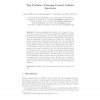Free Online Productivity Tools
i2Speak
i2Symbol
i2OCR
iTex2Img
iWeb2Print
iWeb2Shot
i2Type
iPdf2Split
iPdf2Merge
i2Bopomofo
i2Arabic
i2Style
i2Image
i2PDF
iLatex2Rtf
Sci2ools
NETWORKING
2011
2011
The Problem of Sensing Unused Cellular Spectrum
Abstract. Sensing mechanisms that estimate the occupancy of wireless spectrum are crucial to the success of approaches based on Dynamic Spectrum Access. In this paper, we present key insights into this problem by empirically investigating the design of sensing mechanisms applied to check the availability of excess capacity in CDMA voice networks. We focus on power-based sensing mechanisms since they are arguably the easiest and the most cost-effective. Our insights are developed using a unique dataset consisting of sensed power measurements in the band of a CDMA network operator as well as “ground-truth” information about primary users based on operator data. We find that although power at a single sensor is too noisy to help us accurately estimate unused capacity, there are well-defined signatures of call arrival and termination events. Using these signatures, we show that we can derive lower bound estimates of unused capacity that are both useful (non-zero) and conservative (n...
| Added | 16 Sep 2011 |
| Updated | 16 Sep 2011 |
| Type | Journal |
| Year | 2011 |
| Where | NETWORKING |
| Authors | Daniel Willkomm, Sridhar Machiraju, Jean Bolot, Adam Wolisz |
Comments (0)

